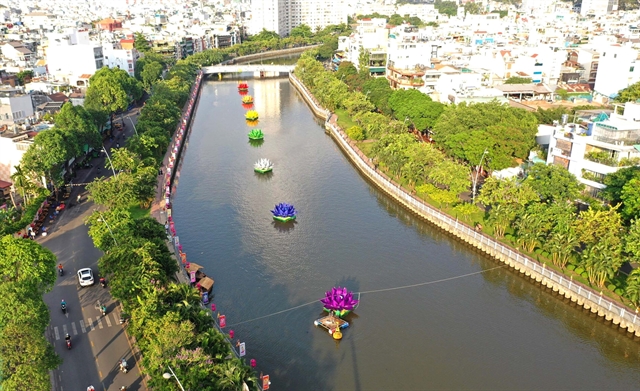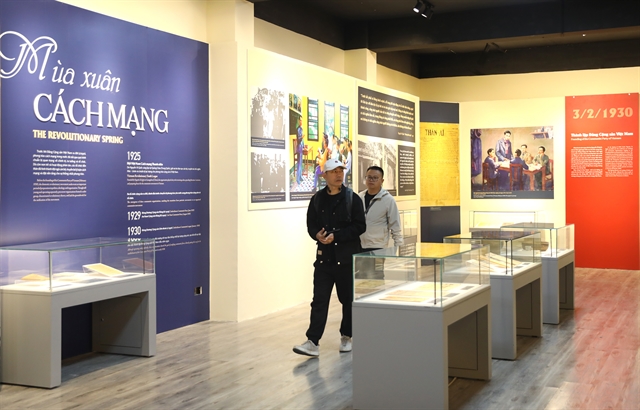 Environment
Environment

The 10-kilometre Nhiêu Lộc-Thị Nghè Canal running through districts 1, 3, Tân Bình, Phú Nhuận, and Bình Thạnh in HCM City has become a popular place for sightseeing, taking photos and doing exercises.

|
| Nhiêu Lộc-Thị Nghè Canal running through HCM City’s districts 1, 3, Tân Bình, Phú Nhuận, and Bình Thạnh has become clean and green. — VNA/VNS Photo Thanh Vũ |
HCM CITY — The 10-kilometre Nhiêu Lộc-Thị Nghè Canal running through districts 1, 3, Tân Bình, Phú Nhuận, and Bình Thạnh in HCM City has become a popular place for sightseeing, taking photos and doing exercises.
Its water has been cleaned, and trees and flowers have been grown on both banks, creating a beautiful green setting.
It used to be the most polluted water body in the city, and one of the most foul-smelling, that people disliked going past it.
A project to improve the canal was started in 2002. An underground drainage system was built to collect and treat wastewater from households and commercial establishments.
The canal’s banks were consolidated.
The work cost nearly VNĐ8.6 trillion (US$370 million).
But now the canal has been revived and has a clean and green atmosphere to the delight of nearly 1.2 million people living around it.
On May 20 the Waterway System Management Centre said 122,000 cubic metres of mud was dredged from the canal in three phases, making the water cleaner than ever.
The mud was dumped in city waste treatment plants.
The city is now carrying out work to restore the Sài Gòn and Đồng Nai Rivers and replicate the beautiful urban scene created around the Nhiêu Lộc-Thị Nghè Canal.
The Tân Hóa-Lò Gốm Canal in districts 6, Tân Phú and Tân Bình was also cleaned with the streets around it upgraded and widened from six metres to 20m, and 10 bridges rebuilt over the canal.
Wastewater from households and production establishments in a 19sq.m area around the canal is collected in a drainage system, preventing floods caused by tides and heavy rains in the Tân Hóa-Lò Gốm area, which used to be a big problem, especially on Bàu Cát, Âu Cơ and Hòa Bình streets.
Nguyễn Hùng Vọng of Tân Phú District told Việt Nam News: “In heavy rains Bàu Cát Street used to be flooded so severely that I could not drive my motorbike. I had to move out to another district to live.”
Many new houses and apartment buildings have now been built around the canal.
Nguyễn Đình Đức of District 6 said people’s lives there have improved and they have escaped the severe pollution.
In District 12, the second phase of the clean-up of the Sơ Rơ Canal was completed last month, with an embankment being built.
Many others such as Hàng Bàng Canal in districts 5 and 6 and A41 Canal in Tân Bình District have also been improved.
Between 2016 and 2018, the city dredged 81.2km of rivers and canals. The public was encouraged to join in dredging 193 canals, helping clear the flow of water and improve hygiene.
The city is next completing procedures to improve the Xuyên Tâm and Tham Lương-Bến Cát canals. The large projects will need thousands of billions of đồng.
Under its master plan, the city will expand the drainage network from 650sq.m to 2,095sq.m by 2030. Thus, dredging canals will continue to be a priority task.
It will also remove 20,000 households living on or near canals, already relocating 1,086 of them. This year another 2,487 will be moved out.
The biggest difficulty facing urban development and water body improvement is the lack of funds.
The eight-kilometre Xuyên Tâm Canal through Bình Thạnh and Gò Vấp districts has been encroached upon by many households, leading to its narrowing and conversion into little more than a large drainage.
Cleaning it would cost around VNĐ9 trillion.
The HCM City Infrastructure Management Centre has instructed district authorities to forcibly take back encroached lands to revive canals, and pay people who live near water bodies but have land use rights to move out.
Economists suggested that the best solution to speed up canal improvement is to solicit private investment under public-private partnerships.
The centre plans to itself inspect and prevent illegal encroachment of canals in future.
The city suffered from such encroachment at 67 sites, and, often, flooding, but resolved 34 of them.
The A41 Canal and a section of the Hy Vọng Canal have been illegally occupied, leading to flooding around the busy Tân Sơn Nhất International Airport. — VNS




